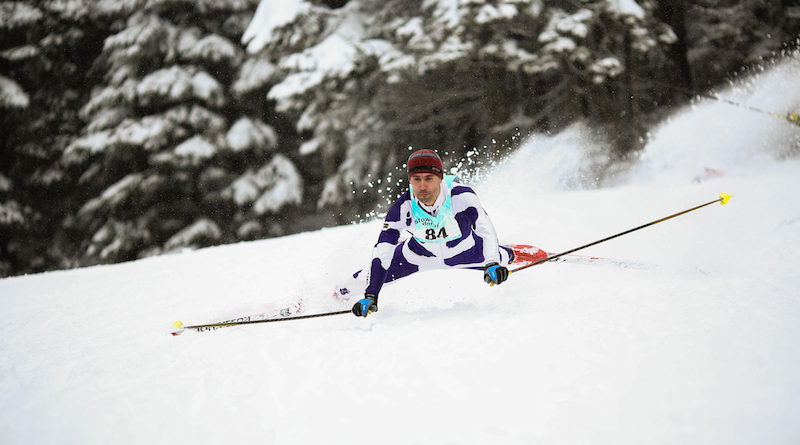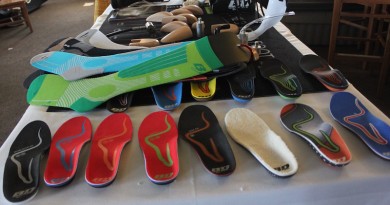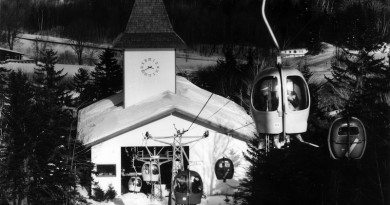The Craziest Race
The craziest and best-loved of bucket-list cross-country races, the Stowe Derby turns 75 this year. And anyone can compete—truly anyone.
“You should race The Derby, it will be fun,” Kim Brown said. This was two decades ago. Since then, I’ve learned that when Kim Brown (a grizzled ski bum who has penned a column in The Stowe Reporter) says anything will be “fun,” to be suddenly busy that day. If that doesn’t work, back out. If all else fails, bring Band-Aids.
Back then, I didn’t know how much I didn’t know. For instance, I didn’t know that you needed more than three days to learn to cross-country ski and way, way
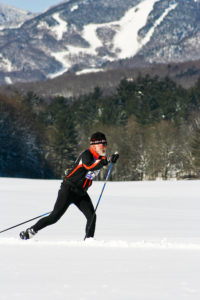
more time to become proficient on skate skis.
“You should do it on skate skis,” Brown added.
I didn’t know that the skate ski division of the Stowe Derby drew some of the top Nordic racers in the East—we’re talking collegiate champions, ex-Olympians and top Masters’ racers, some doing the race twice (once on Nordic and once on skate skis) in one day to vie for the title of Derby Meister. And I didn’t fully understand that much of the course was a screaming downhill.
But the picture Brown and others had painted of this historic race from near the top of the alpine trails at Stowe Mountain Resort, some 13 miles to the finish at the heart of Stowe village, was so compelling I signed up.
“No one takes it too seriously,” Brown promised. “People dress up in costumes. Some people bring picnics. There will be tons of spectators ringing cowbells to cheer you on.”
And, what clinched the deal: “It’s a bucket list race and there’s a great party after.”
The Bet
More than anything, it’s the legend behind the race that makes it irresistible. In the early 1940s, Sepp Ruschp and Erling Strom began racing each other down Mt. Mansfield and into the village of Stowe, trying to settle an informal wager. If you take connecting trails, the distance from the top of the mountain to the center of town is about 20k and roughly one-third downhill, one-third flat and one-third rolling terrain.
Ruschp, an Austrian ski racer, was the founder of the Stowe ski school at Mt. Mansfield and private instructor to AIG insurance icon C.V. Starr. He would, along with Starr, end up running what is now Stowe Mountain Resort.
Norwegian Erling Strom was a Nordic skier who made the first ski ascent of Alaska’s Mt. McKinley (now called Denali) and competed as a ski jumper in Stockholm’s Nordic Winter Games, a precursor to the Winter Olympics. He had moved to Stowe in 1940 and operated an inn in the red brick building that has recently housed several Mexican restaurants (first The Cactus Café and now Over the Wall).
In 1945, Ruschp, Strom and two others made it an official race, open to men older than 30. The two started near the top of the Toll Road on Mt. Mansfield, Ruschp on alpine gear and Strom using mountaineering skis–more akin to today’s cross-country gear. Ruschp beat out Strom and the annual challenge was born, maintaining the rule you could do it on any type of skis, but you had to use the same pair for the whole race.
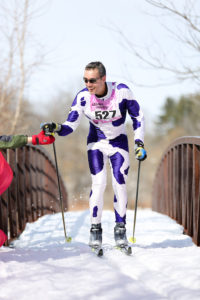
“In its heyday, the Derby drew 800 people or more and it was as much about having fun as competing,” local skier Cap Chenoweth remembers. It seemed that everyone in town, no matter their skill level, did it and folks drove from all over the East Coast to join in.
“People made a day of it. They dressed up. They set up picnic tables mid-course and served wine. College teams would compete but there were also a lot of families and friends who entered as teams,” Chenoweth recalls. “I mean how many other races can you say you competed on the same course as an Olympian?” he asks.
His favorite team called themselves the “Moose.” “They wore moose antlers and made sure that they had someone in each age group whose sole mission was to finish dead last – which meant you were never dead last because there was always a Moose behind you,” Chenoweth says with a grin.
“It did get competitive for a while and that’s when they split the Nordic and the Freestyle, or skate skiing, divisions into two starts,” he notes (some still do it on alpine or randonee gear). The Derby also added a short course for kids and, in 2011 a fat bike division.
Chenoweth, who has raced in 34 Derbys, was one of the first to do both ski races in one day, a competition that became known as the Derby Meister. “At the time, we didn’t bus people back up the hill. Once you got into town, you had to figure out how to get back to the top of the mountain in time for your start.”
But, as with all things Derby, there were also plenty of amateurs for whom simply finishing with as few wipe-outs as possible was the goal.
When I ask Chenoweth what his favorite Derby was, he doesn’t hesitate: “It was one of my first: I was wearing blue jeans and I had a tube of klister wax explode in my pocket. Then, crossing the West River on a narrow plank (on skinny skis), I fell in. But I loved it. You see, the thing about the Derby is you just want to finish. If you make it through the course, you’re a winner.”
That course has typically started just below Stowe’s Octagon, on the Toll Road, descended to the Stowe Cross Country Center, risen up through some of the trails of the Trapp Family Lodge before crossing the flat farm meadows then taking the rec path, which crosses multiple foot bridges. It is, if nothing else, a breathtakingly scenic route.
However, the course is snow dependent and has often been rerouted if conditions warrant. And from 2016 to 2018, Mother Nature conspired to throw everything she had at it: no snow, too much snow, ice storms, you name it.
Three years in a row, it was cancelled due to conditions. Then it came back in 2019 and this year it is scheduled for Sunday, February. 23.
How To Win The Derby
That first year racing the Derby I rode up on the double chair, praying that the skinny skis dangling from my rented boots wouldn’t fall off. At the top, many of the Freestyle division racers were milling around in speed suits. I was wearing a down jacket. The day before it had been 60 degrees and raining. That morning it was 10 degrees.
I lined up with my heat—five racers across—and when Chenoweth, the starter, set us off, adrenaline kicked in. Channeling my inner alpine racer, I tucked and went for the inside of the first turn. The surface felt as icy as a luge run. Though my mind said “turn, turn, turn” my skis went straight, I launched into the woods, taking out the four competitors on my outside. This happened three turns in a row. The crowds that had lined up trailside to watch the carnage loved it. The other racers? Some were laughing as hard as I was. Others, not so much.
But by the time we reached the open meadows I was starting to enjoy myself. There is a palpable sense of accomplishment when you can see both the mountain behind you and the steeple of the church in town ahead.
I finished bruised, scraped and in need of a Band-Aid, or five. I’d done it. And I was determined to do it again.
The next time I did the Derby, I did it right. I entered the classic ski division with a team of girlfriends. We carried backpacks. As friends stationed at one turn franticly rang cowbells for us, screaming “go faster, go faster!” we intentionally came to a dead stop, broke out a picnic blanket and settled in with wine and cheese. Skiers dressed in tutus, cow suits and lederhosen all passed us.
Still, we were not last. There was, of course, a Moose.
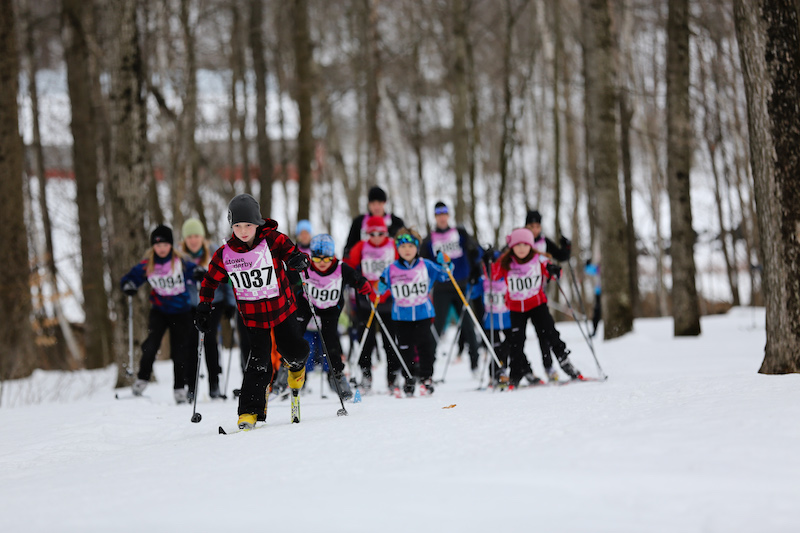
Featured Photo: Since 1945, skiers have been racing from near the top of Stowe into town, usually on Nordic gear (though the freestyle division is open to any ski.) Photo by Benjamin Bloom/MMSC

